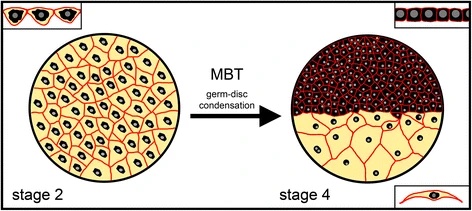First thing I had to check in the lab this morning was the status of the spider couples I’d paired off yesterday, one pair seen in this video. I half expected carnage, with the grooms all bled dry and the brides bloated with spider juice.
But no! No deaths at all! All of them were resting quietly, a couple of them were even snuggled up together. It was very sweet. I still separated them all this morning, you know, just in case. After class today I’ll be moving the females into extra-large, roomy, deluxe cages, where they can produce all the egg sacs I could dream of. Don’t tell them, but I’ll need a fresh egg sac soon — I’m going to be popping out eggs and embryos, fixing them, and staining them a few at a time over the next few weeks with DAPI. Anyone got a good DAPI protocol for spiders? Or fruit flies? (This one will probably do. I also see that the embryos at the mid-blastula transition look, in some ways, like good ol’ zebrafish.)

Germ-disc formation in Parasteatoda tepidariorum. A contiguous blastoderm is present at stage 2 of embryonic development. The mid-blastula transition (MBT) is at the end of stage 2 and germ-disc formation needs the onset of zygotic gene expression. The germ-disc is formed by a condensation like mechanism. Cell membranes (red); nuclei (grey circles); perinuclear cytoplasm (black); yolk (yellow). Upper left corner: schematic representation of the cross-section of blastodermal cells (st. 2). Upper right corner: schematic representation of the cross-section of germ-disc cells (st. 4). Lower right corner: schematic representation of the cross-section of an extra-embryonic cell (st. 4). Not to scale
Meanwhile, that other egg sac I’ve had my eye on as being close to emergence is still doing nothing. The biggest difference between Parasteatoda tepidariorum and Steatoda triangulosa that I’m seeing is that P tep develops like lightning while S stri dawdles along. That may be an advantage for me since I have to interleave everything with a fairly robust teaching load.


That’s certainly great news the males didn’t get eaten!
PZ and all arachnophiles, you must see this:
https://www.geekculture.com/joyoftech/joyarchives/2922.html
That was so cute, shermanj!